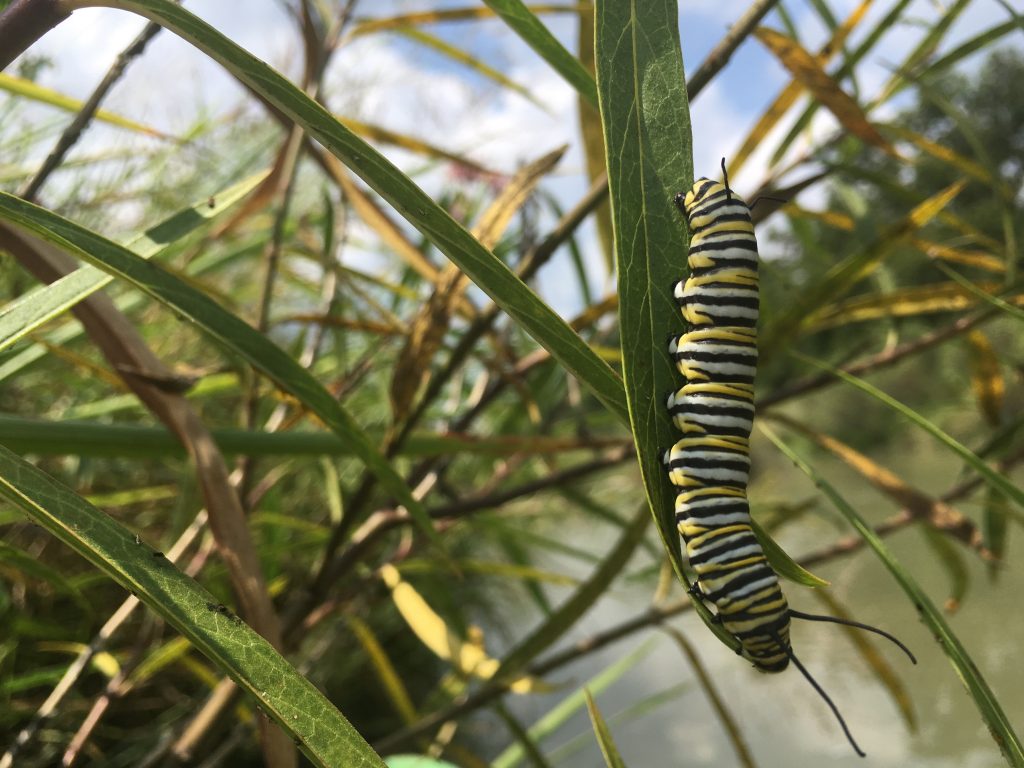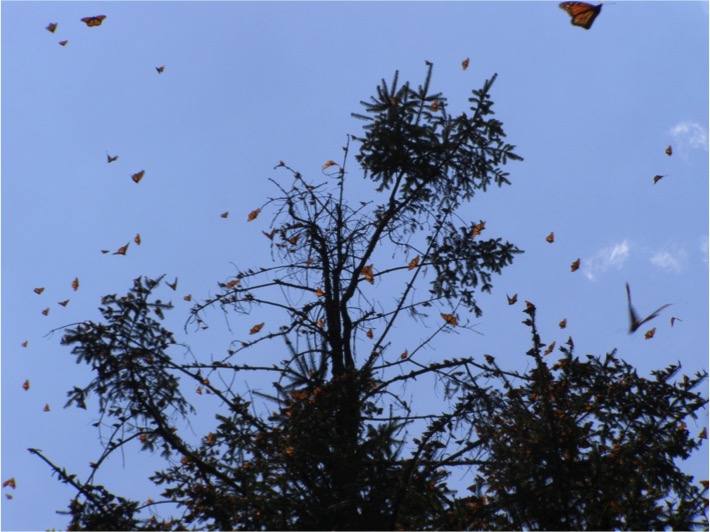“Each one is a hole in the sky through which we can get a glimpse of heaven”.
–Mississippi wildlife artist Walter Anderson
That was how moderator Dan Goodgame launched our Climate Change and the Monarch Butterfly Migration Symposium October 21 at the Pearl Studio.

The “new normal”? Monarch butterflies continued to reproduce late into the season this year as warm temperatures caused many to break their diapause and lay eggs rather than migrate. Photo by Monika Maeckle
The 89-minute discussion was just one of three events that made San Antonio’s first Monarch Butterfly and Pollinator Festival–three-days of art, science and celebration commemorating our favorite migrating insect, Danaus plexipus–such a success last month.
We share the video of that symposium in its entirety today, thanks to the generous support of the John and Florence Newman Foundation, a San Antonio foundation that invests in progressive initiatives in San Antonio and beyond.
Questions raised in the symposium discussion are timely given the recent election and the long, late extremely unusual migration of Monarchs this season. As Thanksgiving approaches, many of us are STILL seeing Monarch butterflies in our gardens and wildscapes; policy questions about how President-elect Trump will address climate change and pollinator advocacy hang in the balance.
The symposium brought together an equal number of scientists and citizen scientists representing all three countries touched by the Monarchs’ North American travels to a sold-out house.
On the panel:
 Dr. Katherine Hayhoe, rock star climate change expert from Texas Tech University. Born in Canada, Hayhoe “grew up with Monarchs” and had just returned from a visit to the White House where Leonardo DiCaprio asked her for her autograph.
Dr. Katherine Hayhoe, rock star climate change expert from Texas Tech University. Born in Canada, Hayhoe “grew up with Monarchs” and had just returned from a visit to the White House where Leonardo DiCaprio asked her for her autograph.
Cathy Downs, from Comfort, Texas, works as an education  outreach specialist for Monarch Watch.
outreach specialist for Monarch Watch.
 Mexican forester Dr. Cuauhtémoc Saenz Romero, of Michoacán, had been visiting Trinity University as a guest professor inecologicalsciences; Dr. Saenz Romero studies the Oyamel forest where the Monarchs roost each winter.
Mexican forester Dr. Cuauhtémoc Saenz Romero, of Michoacán, had been visiting Trinity University as a guest professor inecologicalsciences; Dr. Saenz Romero studies the Oyamel forest where the Monarchs roost each winter.
 MonikaMaeckle, of the Texas Butterfly Ranch. That’s me. I was on the panel, but we didn’t plan it that way. At the last minute, our good friend Catalina Trail, founder of the Monarch butterfly roosting sites in 1975, was unable to attend because of a medical condition. I took her place.
MonikaMaeckle, of the Texas Butterfly Ranch. That’s me. I was on the panel, but we didn’t plan it that way. At the last minute, our good friend Catalina Trail, founder of the Monarch butterfly roosting sites in 1975, was unable to attend because of a medical condition. I took her place.
The lively discussion touched on everything from the pros and cons of Tropical milkweed Asclepias curassavica, to whether or not “assisted migration,” or moving the Oyamel forest in Mexico where the Monarchs roost 2,000 feet higher in elevation to save it from climate change constitutes “interfering with nature.” Mitchell Hagney of the Rivard Report wrote a great wrap-up of the symposium the day after it happened.
At almost 90 minutes, the video may be a bit long for some. Thus, I have noted what I found to be some of the more interesting points with time stamps so those in a rush can skip to the parts that most interest them.
Two videos are also embedded in this one. Our butterfly friendly San Antonio Mayor Ivy Taylor, whose signature on the National Wildlife Federation’s Mayor’s Monarch Pledge made San Antonio the first Monarch Champion City in the country, recorded a welcome video for the Festival since she was unable to join us because of a previous commitment. That two-minute video can be viewed at minute 2:17, or you can watch it at the bottom of this post.
Our media partners, the Rivard Report, also made a lovely video with footage taken along the Llano River during peak migration to illustrate a story covering the Festival. That video can be viewed at 4:22.
If you want to skip all that and go straight to the discussion, fast forward to 7:30. Other notes/highlights are noted below.
* * * * * * *
2:17 Mayor Taylor’s Welcome Video. “I can’t think of a better symbol of the bonds we share as people and as nations than the Monarch Butterfly,” says San Antonio Mayor Ivy Taylor.
4:22 Rivard Report video.
7:30 Moderator Dan Goodgame introduces panelists.
10:25 Video “Get Well Card” for Catalina Trail, from audience.
11:27 Maeckle explains how she came to know Catalina Trail.
16:01 Cathy Downs offers a state-of-the-union of the Monarch butterfly population.
19:27 Dr. Hayhoe discusses how climate change works as a “threat multiplier” to the Monarch butterfly migration and many other issues.
21:06 Dr. Saenz Romero explains how the unique ecosystem of the Oyamel fir forests in Mexico serves as a blanket for the Monarchs’ in the winter, raising the temperature up to 10 degrees under the forest canopy, keeping the Monarchs from freezing.

Dr. Saenz Romero discussed how drought and extreme weather has been tough on the Oyamel trees. They can’t get enough water from the soil during the dry season to keep the tree tops from dying. Photo by Dr. Cuauhtémoc Saenz Romero
28:35 Dr. Saenz Romero introduces the “radical” idea of moving the forest. “I may be crucified by some ecologists,” he says.
“So when you plant Oyamel at higher altitudes than it exists today, we have to move the population higher. Then we have to hope, some say pray, that the Monarchs will change the location of their overwintering sites. We don’t know if it will happen. As you know, the generation that got to Mexico had never been to Mexico.”
“By 2090 there will not be a single square kilometer of climate that is good for the trees where the Monarchs go for over wintering.” –Dr. Saenz Romero
32:30 Dr. Saenz Romero bemoans the challenges of moving the forest higher, noting that even though “there’s no soil” above the tree line, that has not stopped avocado growers from trucking in soil to Michoacán to grow avocados “for your Superbowl.”
35:05 Goodgame poses the question: will the butterflies follow the forest up the mountain if the Oyamel forest is moved? Downs tackles the question.
36:43 Hayhoe chimes in that indeed the butterflies could adapt—if they have time, “So after the last ice age there was a huge warming of the planet. That warming happened over 10-50 times longer than what we are seeing today.”
“If the climate changes more slowly, will the butterflies adapt? I think the answer is, yes. Without a doubt. I think the question really is: can they adapt this quickly without help? And it isn’t just the butterflies.”–Dr. Hayhoe
39:30 Cathy Downs suggests what we can do to mitigate the damage of climate change, including planting milkweeds and late season nectar plants.
43:30 Downs and Maeckle discuss the odd, late Monarch migration this fall and how Monarchs are more frequently breeding this season. “They aren’t supposed to do that, they aren’t reading the book!” says Downs. “They are supposed to be in diapause.”
44:00 Maeckle brings up the Tropical milkweed debate—the question of what are native plants in the Monarch world. “If it’s ok to move a forest out of its native zone, why not a host plant?”
45:39 Saenz attempts to answer the question.
48:19 Dr. Hayhoe offers ideas about how to talk about climate change. “The reason why we care about a changing climate is because it takes something that we already care about, that we’re already concerned about, and it puts that extra straw on the camel’s back.” she says. “So in the case of the butterflies, there are already many reasons to be concerned.”
“What is climate change doing to the butterflies?” It’s doing a few different things. It is actually changing their phenology—what does that mean? It means when they breed and when they migrate. We just heard first-hand witnesses of how things are changing, and they’re changing because the warm temperatures are throwing off the butterflies’ internal calendars.” –Dr. Hayhoe
50:50 Hayhoe offers that we need to build resilience and wean ourselves from fossil fuels. She expresses hopefulness tied to the Paris Climate Change Treaty.
54:32 Saenz answers Goodgame’s question about how ecotourism is effecting the roosting sites—hurting or helping?
“Tourism is very positive at overwintering sites, because there is a very severe restriction to cut trees today, because it’s a biosphere reserve in the core area, so nearly the only income alternative to cut trees is to have ecotourism.”–Dr. Saenz Romero
56:10 Saenz Romero expresses pessimism about the voluntary enforcement of the Paris Climate Treaty, as Mexico begins oil drilling in the ocean and continues to import oil from Australia.
58:44 Goodgame introduces the issue of the possible copper mine at the Monarch roosting sites in Mexico.
1:01:15 Question from the audience: Should the mastodons still be alive today?
1:03:55 Goodgame follows up: Is the issue that the butterfly will go extinct, or that it just stops migrating?
Maeckle answers with a question: why do insects migrate? For shelter, for host plant, to reproduce. And if the Monarch butterfly can have local milkweed and mates here in San Antonio or Houston or Florida, why should they migrate? Why would they migrate?
“Is it a vanity for us as human beings for us to expect this insect to make that journey so we can be marveled, so we can appreciate it? And what would the butterfly say if we could interview the butterfly?”–Maeckle
1:05:52 Downs debates the pros and cons of migratory vs. local Monarch butterfly populations. “Personally, I think it’s important and I’m all for the vanity of that.”
1:13:56 What are the impacts of pesticide use?
1:16:08 Is Tropical milkweed good or not?
1:19.08 Do the two or three milkweeds in my yard make a difference?
1:19:58 Are we preventing adaptation by interfering with nature?
1:20:54 What other species of trees are part of the forests where the Monarchs roost? What is the reforestation plan for the Oyamel forest?
1:23:00 What is the forest going to look like in 50 years? And is there a possibility that the Monarchs would roost there on other species?
1:26:46 How will climate change impact predation pressure on Monarchs?

Related posts:
- Climate change expert Dr. Katharine Hayhoe at TribuneFest: “Hopelessness is hopeless.”
- Coming soon: Grupo Mexico copper mine in heart of Monarch butterfly roosting sites?
- Tropical milkweed OK for Monarch butterflies, ‘Just cut the dang stuff down’
- Scientists try to assess Monarch butterfly mortality after Mexican freeze
- At least 1.5 million Monarch butterflies perish in freak Mexican snowstorm
- Good news! Monarch butterfly population triples
- Thanks, climate change! 9.5-inch Llano River rain dump exemplifies extreme weathe
- Resilience Required: Climate Change Turns up the Heat in the Butterfly Garden
- Mighty Monarch butterflies brave south winds, Hurricane Patricia to arrive in Mexico
- Will the Monarch Migration Become Extinct?

Thank you for all that you do including keeping the rest of us informed.
Although the symposium was about the potential effects of possible future major warming of the climate at the overwintering forests in Mexico and in Texas during the fall migration in October, no historical climate data for those regions was presented. I looked up the historical average temperature data for Texas during October for the past 100 years and came up with this graph that shows no major warming: http://imageshack.com/a/img924/4476/oq2aS9.jpg Perhaps there has also
been little or no warming in the overwintering region in Mexico and unfortunately this vital data was not provided. Nor was evidence provided showing whether the overwintering butterflies in Mexico or the oyamel fir trees themselves have been moving to higher altitudes in recent decades in response to warming (if there has been much of any).